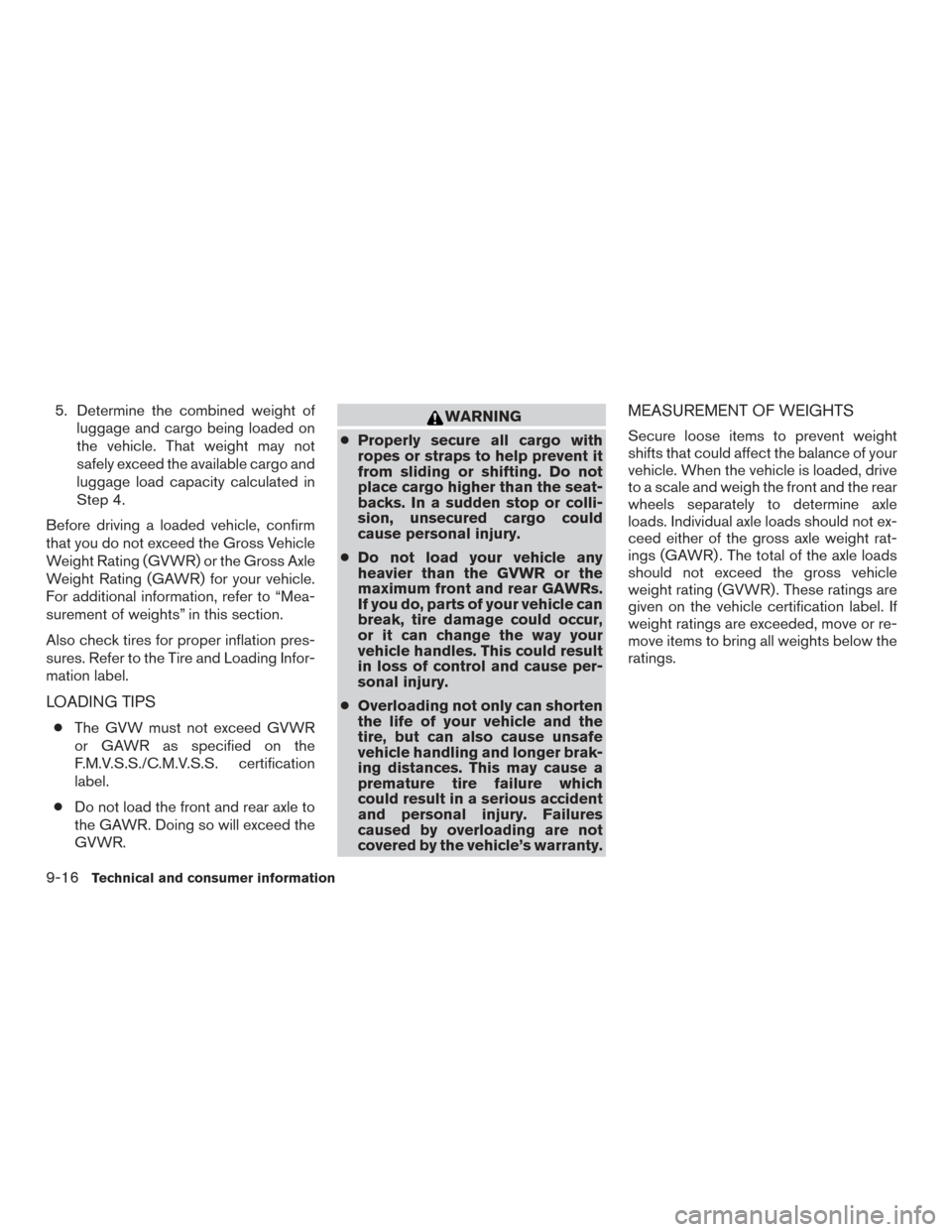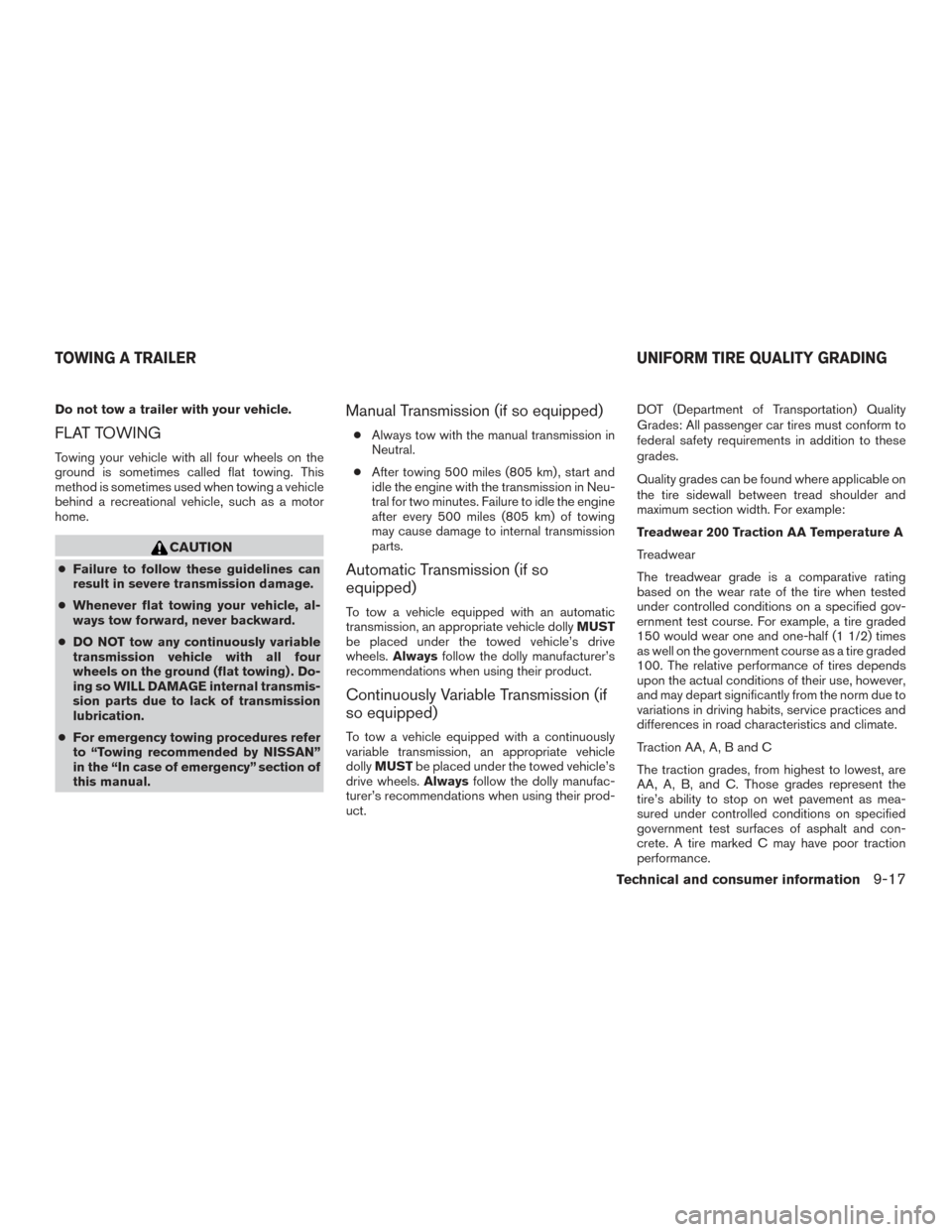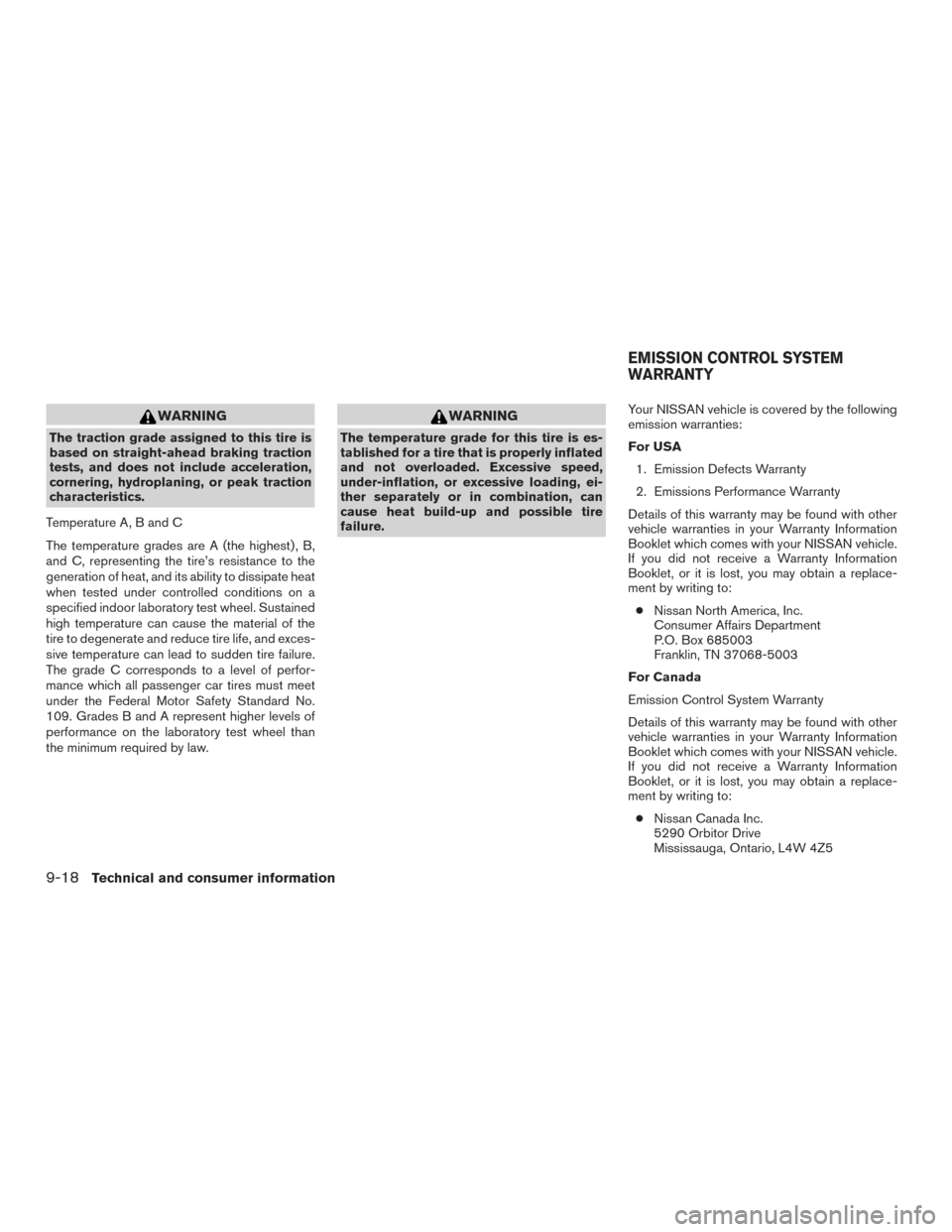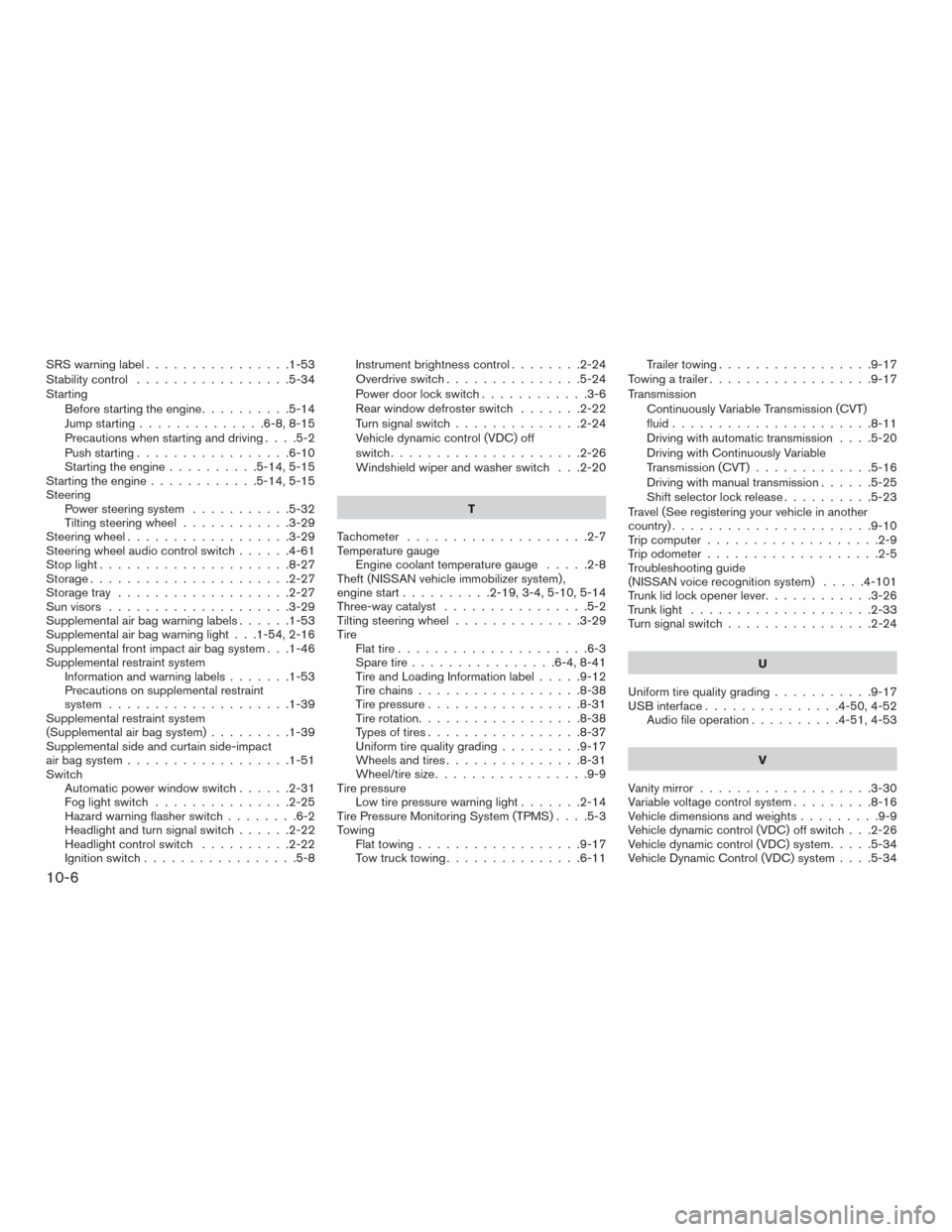2015 NISSAN VERSA SEDAN flat tire
[x] Cancel search: flat tirePage 359 of 374

5. Determine the combined weight ofluggage and cargo being loaded on
the vehicle. That weight may not
safely exceed the available cargo and
luggage load capacity calculated in
Step 4.
Before driving a loaded vehicle, confirm
that you do not exceed the Gross Vehicle
Weight Rating (GVWR) or the Gross Axle
Weight Rating (GAWR) for your vehicle.
For additional information, refer to “Mea-
surement of weights” in this section.
Also check tires for proper inflation pres-
sures. Refer to the Tire and Loading Infor-
mation label.
LOADING TIPS
● The GVW must not exceed GVWR
or GAWR as specified on the
F.M.V.S.S./C.M.V.S.S. certification
label.
● Do not load the front and rear axle to
the GAWR. Doing so will exceed the
GVWR.
WARNING
● Properly secure all cargo with
ropes or straps to help prevent it
from sliding or shifting. Do not
place cargo higher than the seat-
backs. In a sudden stop or colli-
sion, unsecured cargo could
cause personal injury.
● Do not load your vehicle any
heavier than the GVWR or the
maximum front and rear GAWRs.
If you do, parts of your vehicle can
break, tire damage could occur,
or it can change the way your
vehicle handles. This could result
in loss of control and cause per-
sonal injury.
● Overloading not only can shorten
the life of your vehicle and the
tire, but can also cause unsafe
vehicle handling and longer brak-
ing distances. This may cause a
premature tire failure which
could result in a serious accident
and personal injury. Failures
caused by overloading are not
covered by the vehicle’s warranty.MEASUREMENT OF WEIGHTS
Secure loose items to prevent weight
shifts that could affect the balance of your
vehicle. When the vehicle is loaded, drive
to a scale and weigh the front and the rear
wheels separately to determine axle
loads. Individual axle loads should not ex-
ceed either of the gross axle weight rat-
ings (GAWR) . The total of the axle loads
should not exceed the gross vehicle
weight rating (GVWR) . These ratings are
given on the vehicle certification label. If
weight ratings are exceeded, move or re-
move items to bring all weights below the
ratings.
9-16
Technical and consumer information
Page 360 of 374

Do not tow a trailer with your vehicle.
FLAT TOWING
Towing your vehicle with all four wheels on the
ground is sometimes called flat towing. This
method is sometimes used when towing a vehicle
behind a recreational vehicle, such as a motor
home.
CAUTION
●Failure to follow these guidelines can
result in severe transmission damage.
● Whenever flat towing your vehicle, al-
ways tow forward, never backward.
● DO NOT tow any continuously variable
transmission vehicle with all four
wheels on the ground (flat towing) . Do-
ing so WILL DAMAGE internal transmis-
sion parts due to lack of transmission
lubrication.
● For emergency towing procedures refer
to “Towing recommended by NISSAN”
in the “In case of emergency” section of
this manual.
Manual Transmission (if so equipped)
● Always tow with the manual transmission in
Neutral.
● After towing 500 miles (805 km) , start and
idle the engine with the transmission in Neu-
tral for two minutes. Failure to idle the engine
after every 500 miles (805 km) of towing
may cause damage to internal transmission
parts.
Automatic Transmission (if so
equipped)
To tow a vehicle equipped with an automatic
transmission, an appropriate vehicle dolly MUST
be placed under the towed vehicle’s drive
wheels. Always follow the dolly manufacturer’s
recommendations when using their product.
Continuously Variable Transmission (if
so equipped)
To tow a vehicle equipped with a continuously
variable transmission, an appropriate vehicle
dolly MUST be placed under the towed vehicle’s
drive wheels. Alwaysfollow the dolly manufac-
turer’s recommendations when using their prod-
uct. DOT (Department of Transportation) Quality
Grades: All passenger car tires must conform to
federal safety requirements in addition to these
grades.
Quality grades can be found where applicable on
the tire sidewall between tread shoulder and
maximum section width. For example:
Treadwear 200 Traction AA Temperature A
Treadwear
The treadwear grade is a comparative rating
based on the wear rate of the tire when tested
under controlled conditions on a specified gov-
ernment test course. For example, a tire graded
150 would wear one and one-half (1 1/2) times
as well on the government course as a tire graded
100. The relative performance of tires depends
upon the actual conditions of their use, however,
and may depart significantly from the norm due to
variations in driving habits, service practices and
differences in road characteristics and climate.
Traction AA, A, B and C
The traction grades, from highest to lowest, are
AA, A, B, and C. Those grades represent the
tire’s ability to stop on wet pavement as mea-
sured under controlled conditions on specified
government test surfaces of asphalt and con-
crete. A tire marked C may have poor traction
performance.
TOWING A TRAILER
UNIFORM TIRE QUALITY GRADING
Technical and consumer information9-17
Page 361 of 374

WARNING
The traction grade assigned to this tire is
based on straight-ahead braking traction
tests, and does not include acceleration,
cornering, hydroplaning, or peak traction
characteristics.
Temperature A, B and C
The temperature grades are A (the highest) , B,
and C, representing the tire’s resistance to the
generation of heat, and its ability to dissipate heat
when tested under controlled conditions on a
specified indoor laboratory test wheel. Sustained
high temperature can cause the material of the
tire to degenerate and reduce tire life, and exces-
sive temperature can lead to sudden tire failure.
The grade C corresponds to a level of perfor-
mance which all passenger car tires must meet
under the Federal Motor Safety Standard No.
109. Grades B and A represent higher levels of
performance on the laboratory test wheel than
the minimum required by law.
WARNING
The temperature grade for this tire is es-
tablished for a tire that is properly inflated
and not overloaded. Excessive speed,
under-inflation, or excessive loading, ei-
ther separately or in combination, can
cause heat build-up and possible tire
failure. Your NISSAN vehicle is covered by the following
emission warranties:
For USA
1. Emission Defects Warranty
2. Emissions Performance Warranty
Details of this warranty may be found with other
vehicle warranties in your Warranty Information
Booklet which comes with your NISSAN vehicle.
If you did not receive a Warranty Information
Booklet, or it is lost, you may obtain a replace-
ment by writing to: ● Nissan North America, Inc.
Consumer Affairs Department
P.O. Box 685003
Franklin, TN 37068-5003
For Canada
Emission Control System Warranty
Details of this warranty may be found with other
vehicle warranties in your Warranty Information
Booklet which comes with your NISSAN vehicle.
If you did not receive a Warranty Information
Booklet, or it is lost, you may obtain a replace-
ment by writing to: ● Nissan Canada Inc.
5290 Orbitor Drive
Mississauga, Ontario, L4W 4Z5
EMISSION CONTROL SYSTEM
WARRANTY
9-18Technical and consumer information
Page 368 of 374

F
Flashers (See hazard warning flasher switch) . .6-2
Flat tire .......................6-3
Floor mat positioning aid .............7-6
Fluid Brake fluid ..................8-12
Capacities and recommended
fuel/lubricants .................9-2
Continuously Variable Transmission (CVT)
fluid......................8-11
Engine coolant .................8-7
Engine oil ...................8-9
F.M.V.S.S. certification label ...........9-11
Foglightswitch .................2-25
Front air bag system
(See supplemental restraint system) ......1-46
Frontseats.....................1-2
Fuel Capacities and recommended
fuel/lubricants .................9-2
Fuel economy ................5-30
Fuel-filler door and cap ...........3-27
Fuel-filler door lock opener lever ......3-27
Fuel gauge ...................2-9
Fuel octane rating ...............9-5
Fuel recommendation .............9-4
Loose fuel cap warning ........2-6,3-27
Fuel gauge .....................2-9
Fuses.......................8-20
Fusible links ...................8-20 G
Gascap .....................3-27
Gauge Engine coolant temperature gauge .....2-8
Fuel gauge ...................2-9
Odometer ...................2-5
Speedometer .................2-5
Tachometer ..................2-7
Trip computer .................2-9
Trip odometer .................2-5
General maintenance ...............8-2
Glovebox.....................2-29
H
Hands-free phone system,
Bluetooth®................4-65,4-90
Hazard warning flasher switch ..........6-2
Headlight and turn signal switch ........2-22
Headlight control switch ............2-22
Headlights ....................8-25
Head restraints ..................1-5
Heater Heater and air conditioner controls .....4-15
Heater operation ...............4-17
Hood release ...................3-24
Horn .......................2-25
I
Ignition switch ...................5-8
Ignition Switch Push-Button Ignition Switch ........5-11Immobilizer system
......2-19,3-4,5-10,5-14
Important vehicle information label .......9-11
Increasing fuel economy .............5-30
Indicator lights and audible reminders
(See warning/indicator lights and audible
reminders)....................2-11
Inside mirror ...................3-31
Instrument brightness control ..........2-24
Instrumentpanel...............0-6,2-2
Instrument panel dimmer switch ........2-24
Intelligent Key system Key operating range .............3-13
Key operation ................
3-15
Mechanical key ................3-4
Remote keyless entry operation.......3-18
Troubleshooting guide ............3-23
Warning signals ...............3-23
Interior light ................2-31,2-32
Interior trunk lid release .............3-26
iPod®Player ............... 4-54, 4-56
ISOFIX child restraints .............1-20
J
Jump starting ................6-8,8-15
K
Key.........................3-2
Key fob battery replacement ..........8-23
Keyless entry With Intelligent Key system
(See Intelligent Key system) .........3-18
10-3
Page 371 of 374

SRS warning label................1-53
Stability control .................5-34
Starting Before starting the engine ..........5-14
Jump starting ..............6-8,8-15
Precautions when starting and driving ....5-2
Push starting .................6-10
Starting the engine ..........5-14,5-15
Starting the engine ............5-14,5-15
Steering Power steering system ...........5-32
Tilting steering wheel ............3-29
Steering wheel ..................3-29
Steering wheel audio control switch ......4-61
Stoplight.....................8-27
Storage......................2-27
Storage tray ...................2-27
Sun visors ....................3-29
Supplemental air bag warning labels ......1-53
Supplemental air bag warning light . . .1-54, 2-16
Supplemental front impact air bag system . . .1-46
Supplemental restraint system Information and warning labels .......1-53
Precautions on supplemental restraint
system ....................1-39
Supplemental restraint system
(Supplemental air bag system) .........1-39
Supplemental side and curtain side-impact
air bag system ..................1-51
Switch Automatic power window switch ......2-31
Foglightswitch ...............2-25
Hazard warning flasher switch ........6-2
Headlight and turn signal switch ......2-22
Headlight control switch ..........2-22
Ignition switch .................5-8 Instrument brightness control
........2-24
Overdrive switch ...............5-24
Power door lock switch ............3-6
Rear window defroster switch .......2-22
Turn signal switch ..............2-24
Vehicle dynamic control (VDC) off
switch.....................2-26
Windshield wiper and washer switch . . .2-20
T
Tachometer ....................2-7
Temperature gauge Engine coolant temperature gauge .....2-8
Theft (NISSAN vehicle immobilizer system) ,
engine start ..........2-19,3-4,5-10,5-14
Three-way catalyst ................5-2
Tilting steering wheel ..............3-29
Tire Flat tire .....................6-3
Spare tire ................6-4,8-41
Tire and Loading Information label .....9-12
Tirechains..................8-38
Tire pressure .................8-31
Tirerotation..................8-38
Types of tires .................8-37
Uniform tire quality grading .........9-17
Wheels and tires ...............8-31
Wheel/tire size .................9-9
Tire pressure Low tire pressure warning light .......2-14
Tire Pressure Monitoring System (TPMS) ....5-3
Towing Flattowing..................9-17
Towtrucktowing...............6-11 Trailer towing
.................9-17
Towing a trailer ..................9-17
T
ransmission Continuously Variable Transmission (CVT)
fluid......................8-11
Driving with automatic transmission ....5-20
Driving with Continuously Variable
Transmission (CVT) .............5-16
Driving with manual transmission ......5-25
Shift selector lock release ..........5-23
Travel (See registering your vehicle in another
country) ......................9-10
Trip computer ...................2-9
Trip odometer ...................2-5
Troubleshooting guide
(NISSAN voice recognition system) .....4-101
Trunklidlockopenerlever............3-26
Trunklight ....................2-33
Turn signal switch ................2-24
U
Uniform tire quality grading ...........9-17
USB interface ...............4-50,4-52
Audio file operation ..........4-51,4-53
V
Vanity mirror ...................3-30
Variable voltage control system .........8-16
Vehicle dimensions and weights .........9-9
Vehicle dynamic control (VDC) off switch . . .2-26
Vehicle dynamic control (VDC) system .....5-34
Vehicle Dynamic Control (VDC) system ....5-34
10-6